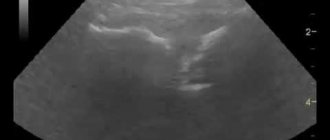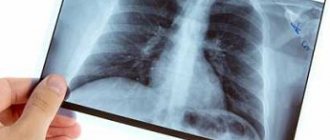Some medical procedures cannot be done too often, while others have contraindications. For many examinations, pregnancy is a contraindication, since the growing fetus is susceptible to any external influences, some of which can be harmful. Is it possible to do fluorography during pregnancy, why is it dangerous for the baby, and what to do if you need to obtain data from this study?
What is fluorography and what is this procedure prescribed for?
Fluorography is considered one of the most common diagnostic methods using unique X-rays. Special radiation is generated in the tube of the medical device, and during the procedure it is directed in a given direction. Some tissues completely absorb X-rays, some do not. In this way, it is possible to record the state of hard and soft tissues and voids, which is reflected in graphical form.
By studying the resulting image, the doctor can determine pathologies of the chest organs. The objects of diagnosis are the lungs, heart, mammary glands, and less often - the skeletal system. One of the main advantages of the method is the ability to identify serious diseases at an early stage: cancer, tuberculosis, pneumonia.
Potential risks when testing in pregnant women
It is difficult to talk about the consequences of fluorography.
Medicine primarily works with indicators and data that are empirically confirmed. To tell about the dangers of certain drugs, they are tested on carefully selected groups of patients. Fluorography of pregnant women in order to study its effect on the body of the mother and child was not carried out en masse, so it is not possible to talk about a reliable effect on the fetus. All ideas about the negative aspects of research are more theoretical research in the area of possible risks. Alcoholism and drug addiction, which are common among young people, have a much worse effect on the fetus. And smoking, which some women do not give up during pregnancy, is much more harmful than the effect of X-rays on the fetus.
Let's take a look at the warnings stated by doctors:
- pregnancy failure is possible, so the woman does not even know about her “interesting situation”;
- minor deviations that do not affect the quality of life are allowed;
- Serious genetic defects and other abnormalities appear that can complicate the child’s life.
If you look at the possible negative consequences, it becomes clear that they are rare, and the birth of children with congenital deformities, pathologies of the structure of internal organs and other diseases is associated primarily with burdened heredity - alcoholism of one or both parents, drug addiction, smoking, or a woman suffering from a viral pathology .
Is FLG done in the maternity hospital?
In many maternity hospitals, before discharge, all women who have given birth are required to undergo fluorography.
However, many mothers are concerned about the safety of this event and its impact on breastfeeding. There is no law requiring all women in labor to undergo this procedure! As well as strict instructions for it. This is recommended for women who have given birth, who have been in contact with people with tuberculosis, or if their family members are suspected. No one has the right to detain you in the maternity hospital without an updated certificate, which is what doctors love to scare.
If you do not agree to this procedure, a refusal is written, the doctor announces the possible risks, and this is the basis for stopping the medical staff’s insistence on this procedure.
On what day after birth is FLG done?
Usually doctors send for fluorography 3-4 days after birth if the dynamics are positive and the mother is feeling well.
This is explained by the fact that even if the certificate is still valid for 2-3 months, immunity during pregnancy and after childbirth is greatly weakened and the likelihood of getting sick increases, so it is important to check this immediately. Moreover, infected cells can live in the body for a long time, and manifest themselves as a result of a serious condition, stress, etc. If mother and child are transferred instead of being discharged to a clinic, the procedure is carried out before departure.
In the first days after birth, performing FLG is extremely undesirable, primarily due to the weakened state of the mother’s body and the formation of lactation.
Does it affect lactation?
There is no officially published information on the effect of radiation received during FLG on lactation.
However, the doctors themselves, directing the nursing mother to the picture, warn that it is best to express milk twice, and only feed the baby the third time. It is generally accepted that this does not affect the mother’s milk supply and will not harm the baby. After the examination, you can take vitamin E - it helps eliminate radicals from the body.
Fluorography during feeding can be done only when indicated, for example, when the disease manifests itself externally or when a positive mantoux reaction occurs. It’s better to take care of yourself during feeding and not expose your baby to unnecessary danger! It is illegal to force someone to go through this against your will!
Is it possible to write a refusal?
If the mother is unwilling, she always has the right to write a refusal, and it is illegal to force her.
You can often hear stories of doctors saying that they will not discharge her from the maternity hospital until the woman has had a chest X-ray taken. This is an illegal act, and no medical procedure can be performed without consent, especially if there are obvious risks during lactation.
Also, do not believe in stories that without a certificate of FLG performed before birth, you will be sent to a ward with sick women. Even for one such statement, a health worker can pay with his career.
What are the risks of research at different stages of pregnancy?
Often women do not know that they are pregnant, so in the early stages they behave as usual and follow all the recommendations of doctors. The same applies to fluorography. What are the dangers of the study if fluorography is done in the early stages of pregnancy?
The most dangerous period is in the first trimester, namely the first eight weeks, when all systems and organs are formed. During this period, doctors do not even advise taking pills, preferring to use alternative methods of treatment. This approach is justified, since during this period, if there is a “failure” in the development of the fetus, serious disturbances can occur.
Speaking about the risks of fluorography in the first trimester, it is classified as a dangerous procedure that can also provoke such consequences. However, in practice, the women who completed the study have completely healthy children, so there is no need to worry about such an effect on the fetus - in the first weeks of pregnancy, fluorography is as harmless as in the second and third trimester.
Is it possible to do fluorography during pregnancy?
Many experts still have not agreed on the degree of harm of fluorographic examination for a pregnant woman. Some of them claim that only with the help of this diagnostic method there is the greatest likelihood of identifying serious diseases in the early stages. Early detection of pathology can prevent serious consequences for a woman and her baby in the future. Other medical luminaries claim that during the procedure, X-ray rays, penetrating deep into the female body, affect the process of division and further growth of cells in the child, which can subsequently lead to congenital anomalies or missed pregnancy. That is why there is no way to predict what consequences the radiation will lead to and how this will further affect the development of the baby.
A pregnant woman is in an extremely difficult situation and cannot decide whether to undergo fluorography or not. Leading doctors in this case agree on one opinion and claim that this study can only be carried out in especially extreme cases, when there is a risk to life, and there are no other ways to confirm or refute the disease.
Why do you need to do the prescribed research?
The first thing to do is to calm down, since the mother’s nervous tension is transmitted to the child and makes his stay in the womb uncomfortable. Why shouldn’t you be afraid of fluorography and what to do before the study?
Fluorography is not prescribed for pregnant women, even if it should be done on schedule. The concept of “possible risks” exempted this category of women from undergoing examination. If a doctor orders a chest exam, there is a good reason for doing so.
Doctors do not send pregnant women for testing who are somatically healthy and do not complain of problems with the respiratory system. If there is a suspicion of tuberculosis, then the woman needs to undergo a fluorographic examination. This is a formidable pathology that does not spare patients, so during pregnancy it can affect the fetus.
The seriousness of tuberculosis is evidenced by the fact that until recently, detection was an indication for artificial termination of pregnancy. And only in recent years can doctors treat a pregnant woman, who must undergo three courses in a hospital over 9 months, and the rest of the time in a specialized dispensary. In some forms of tuberculosis, pregnancy must be terminated.
Therefore, you should not refuse to conduct a fluorographic examination, because if you have tuberculosis, it can be cured and the pregnancy can be maintained. If the pathology becomes more complicated and affects other organs, then the woman faces unfavorable prospects.
How many times should FLG be done after childbirth?
A fluorographic examination after childbirth is prescribed only when indicated, in other words, when symptoms occur or contact with patients.
Then the woman should take a chest X-ray after the complete cessation of lactation and repeat again once a year. In order to be able to take care of your health in a timely manner, the fluorography procedure should not be neglected if you are feeling healthy, as well as when planning a pregnancy. In this case, both future parents should take a photo in the first days of the cycle and use protection until its end.
If the examination took place while you were expecting your baby, don’t panic! Carry out all the tests and think only about the good, negative consequences are not at all necessary, and it is better not to be nervous when you are in this position.
How to properly undergo fluorography during pregnancy
Digital scanning fluorograph (the safest and most modern diagnostic method)
If the doctor has prescribed a test, do not despair. The main thing is to choose the right diagnostic center. Sometimes women do not have the information that radiation exposure can be reduced. Previously, film fluorography gave a significant (not safe) radiation level of 0.1-0.3 mSV. Now it is possible to replace it with digital fluorography 0.02-0.03 mSv - the load is 5 times less than with a conventional study. You just need to choose the center where there is such a device.
During the study, radiation affects only the chest - other parts of the body, including the uterus, are protected by special lead aprons. In some devices they are already built into the panels, and in others the medical staff will give the woman to cover herself with such an apron. Therefore, the rays do not directly affect the fetus.
If the husband refuses to do fluorography
A woman expecting a child must follow all the recommendations of the specialist managing the pregnancy. The future father should also not stand aside, because he is responsible for the health of his wife and their baby.
Men often do not understand why they need to undergo FLG during their wife’s pregnancy, especially if they are not planning a joint birth. Refusal to undergo an examination is an unreasonable and irresponsible action that can cause the following consequences:
- a woman in labor will be denied hospitalization upon admission to the maternity hospital;
- The pregnant woman will be given a referral to the infectious diseases department.
Of course, a woman will not be left without help on the street, but in the infectious diseases department the risk of contracting any infection is too high.
If the future father is still categorical and does not intend to undergo examination, he must provide a written refusal. The application must contain an explanation of the reasons why the man did not undergo the mandatory examination, and the fact of accepting responsibility for the possible consequences of such a decision. But it’s better to think about them so as not to endanger the life of your child, so a pregnant woman’s husband should still undergo fluorography.
Experts' opinion
Doctors are aware of the effect of fluorography on the patient’s body. They know that refusing an examination leads to serious problems - not diagnosing pathologies such as tuberculosis and lung cancer is simply unacceptable when there is every opportunity for this.
The opinions of doctors on whether it is possible to do fluorography for pregnant women are clear - the study is necessary if there are indications for it. Indications for fluorography:
- a positive blood test performed by polymerase chain reaction or enzyme immunoassay;
- sputum examination reveals Mycobacterium tuberculosis or Koch bacilli;
- if there is a fever, cough, sudden weight loss.
A strong recommendation for undergoing fluorography is contact with people suffering from tuberculosis. Doctors insist on such an examination because the disease is dangerous for the woman herself and it can infect other pregnant women. During pregnancy, women visit the gynecological department of the clinic quite often, constantly in contact with the same patients.
It is definitely possible to do fluorography for pregnant women, and if indicated, it is necessary, because this will preserve the health of both the expectant mother and child, as well as those around them.
Does a future father need fluorography?
All people with whom a pregnant woman comes into contact pose a potential danger to her low immunity. But it’s one thing to have passers-by on the street or colleagues, with whom communication is not so close, and contact with a spouse has a completely different level. Knowing that the husband is not a carrier of infections is mandatory for a physician observing a pregnancy. Therefore, a man needs to undergo fluorography a month before conception or on any day of pregnancy. At the planning stage, to be on the safe side, it is better to refrain from trying to conceive for two weeks after the examination - there is no need to avoid ejaculation, just protect yourself with barrier contraceptives such as condoms.
My husband underwent fluorography in June, and when I gave birth in November and the question arose about his admission to the ward where my son and I were lying, they asked him for a certificate. We got married a month before the birth. The exchange card contained information only about my mother and sister, as registered in the same living space. Yura went to the clinic, where he was seated in front of a thick stationery book and asked to look for the result himself. As a result, my husband had to go through the fluorograph again because it was impossible to make out anything in the scribbles. This is another evidence of the advantages of computer FLG - at least the records are stored there better and the words are more legible.
Reviews from women about the procedure
Elena, 24 years old: “I had fluorography done during pregnancy, when I still didn’t know about my situation. Then my mother-in-law scared me that the child would be born with disabilities and I consulted a doctor. They said that nothing bad would happen, and so it was. Just unnecessary worries.”
Irina, 30 years old: “Since I work in the maternity ward, I often undergo fluorography. Before going on maternity leave, I also underwent the study on time - I can’t jeopardize my health and the health of our patients. I know that research does no harm, so I’m not afraid of it.”
Olga, 27 years old: “The story of my pregnancy was not entirely cloudless. My ex-husband suffered from tuberculosis, which I learned about later. The doctors suspected the disease and, fortunately, they did not find tuberculosis in me. That’s how we separated from my husband; he comes from a dysfunctional family, and the child was born healthy. Now I’m again expecting an increase and I know that fluorography is harmless - if necessary, it can be done without fear.”
What to do if you find out about pregnancy after undergoing FLG
Sometimes it happens that a woman finds out about her interesting situation only after she has had fluorography. In such a situation, you should not panic, but consult a gynecologist. There are many known cases of the birth of healthy children after accidental intrauterine exposure to low doses. If fluorography was done before the delay and the fetus did not die, it has every chance of being born without abnormalities. After all, the dose of radiation most likely had no effect on him.
At the maternity hospital, doctors may prescribe an additional ultrasound for you and recommend that you see a geneticist. Fluorography during pregnancy is not a mandatory indication for abortion. The baby will simply have closer medical monitoring. The main thing is not to give in to negative emotions, but to tune in to a favorable outcome.
Video: is fluography harmful for expectant mothers?
When is the early procedure indicated?
In some cases, it is required that the pregnant woman undergo fluorography. In this case, the risk to her health is higher than the harm to the fetus. There are several exceptional cases when a doctor prescribes an X-ray examination for a woman carrying a child:
- She has a progressive disease that cannot be diagnosed or otherwise monitored. These ailments include tuberculosis, oncology of the chest organs, and acute pneumonia.
- The pregnant woman had close contact with people infected with tuberculosis.
- My husband was diagnosed with tuberculosis.
- People infected with tuberculosis live in the same apartment as a pregnant woman.
Without prior consultation with a gynecologist, it is strictly prohibited to independently sign up for fluorography.
Beginning of pregnancy
But after the birth of a new life inside the mother, you should categorically refuse fluorography and other ionizing examinations, unless absolutely necessary. Let us consider with you what the consequences of neglecting this advice may be:
- termination of pregnancy (radiation provokes the process of cell division, and if an adult body can resist such effects, then the small cells of the fetus will certainly succumb to a destructive reaction);
- the risk of developing abnormalities in the development of the child.
These rules apply only to women. Men don't have to be afraid. But still, at least for 6-10 hours they should abstain from unprotected sexual intercourse. Let this be a little precaution for the health of the unborn baby!
Ways to minimize risk
If the expectant mother is suspected of having a disease (pathologies of the lungs, heart, the occurrence of malignant tumors), then you need to try to minimize all possible risks.
How to do it:
- Consult your doctor about the possibility of replacing fluorography with a safer alternative method.
- If it is not possible to replace fluorography, then it is necessary to undergo diagnostics using the latest equipment. If this is not available in a regular clinic, then it is better to pay and undergo the study in paid institutions.
- Before the procedure, it is mandatory to use a lead apron.
- It is necessary to discuss all the positive and negative aspects with the supervising doctor. If possible, postpone the study until after 21 weeks of pregnancy, or better yet, during the postpartum period.
- Minimize exposure to other sources of radiation.
What is fluorography and why do it?
Fluorography is a medical examination using x-rays that pass through the chest. The rays pass through tissues and organs and photograph them.
The image appears due to the fact that the rays pass unevenly through certain places. The finished photograph is captured on film or digitalized (depending on the type of camera). It is displayed on the screen, where it is examined by a radiologist.
This is a diagnosis that is aimed at studying the chest organs. Without a certificate with the result of the study, a person will not be hired by an educational institution on the territory of the Russian Federation. Fluorography is considered a preventive measure to detect diseases in the chest area. But it can be carried out as prescribed by a doctor if certain diseases are suspected.
Fluorography must be done once every year, starting at the age of 15.
What is examined using fluorography:
- heart;
- large vessels;
- mammary glands;
- diaphragm;
- chest skeleton.
There are 2 types of fluorography:
- Film. An old method that uses X-ray film.
- Digital. A new method that helps reduce the radiation dose by 10 times, while delivering better image quality.
Film
An outdated method, which, on the recommendation of the World Health Organization, is abandoned by all developed countries. There is a gradual replacement of film cameras with digital ones. But in Russia, most city clinics are equipped with film devices.
Using it, you can get a picture like this:
- The patient presses his chest against the device and while inhaling, an image is taken.
- The rays pass through the patient's organs and are transferred to the film of the screen located behind.
- From there, the image goes onto the monitor to the doctor for further examination.
This method provides a radiation dose equal to 30% of the annual norm. At the same time, the image quality is at an average level.
Digital
This method works like a digital camera. It is considered more gentle. The radiation dose is about 3% of the annual norm. At the same time, the quality of the image has improved, which will help clarify the patient’s condition.
How to get the image:
- X-ray beams pass through the area of the patient's body being examined.
- Then they go to a special matrix, which digitizes the image and transfers it to the doctor’s computer, where it is stored.
Preparing for the study
Fluorography does not require special preparation of the patient. But during pregnancy you need to be careful not to harm the baby.
A lead apron is a means of protecting the baby in the womb during fluorography and radiography.
Preparation:
- Before the procedure, wear a lead apron. It will help protect the uterus and the child developing in it from radiation.
- The device for carrying out the procedure must be the latest – digital. It is better to undergo the study in a paid clinic (the cost of the procedure is no more than 200 rubles).
- Before fluorography during pregnancy, a visit to a geneticist is considered mandatory. He will be able to assess the gene pool of future parents and determine whether the risk of genetic disorders is high.











